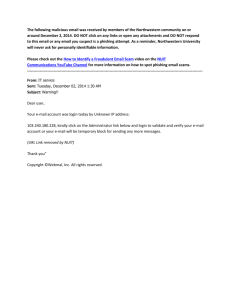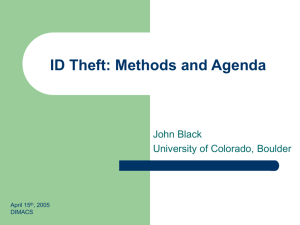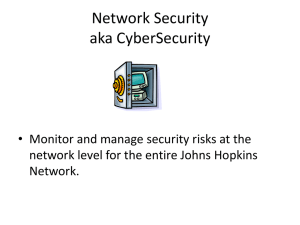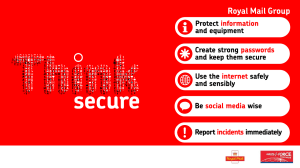Accessing Public WiFi: Security Issues
advertisement
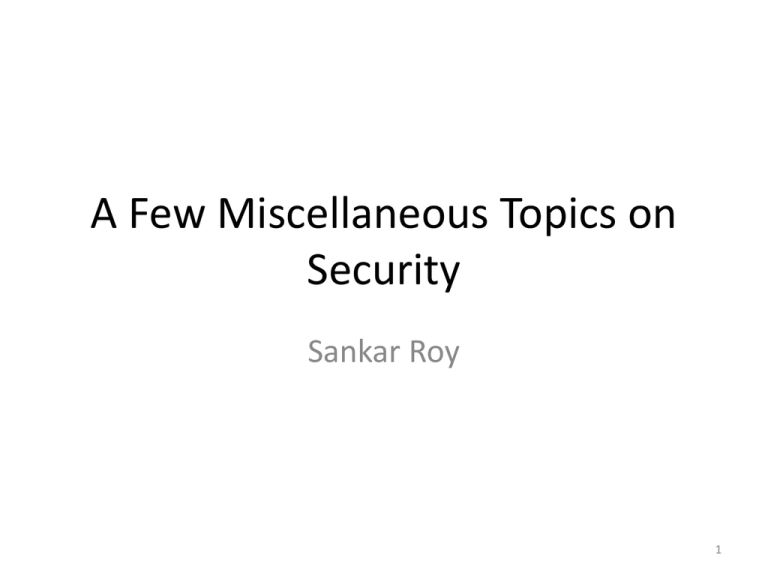
A Few Miscellaneous Topics on
Security
Sankar Roy
1
Acknowledgement
In preparing the presentation slides and the
demo, I received help from
• Professor Simon Ou
• Professor Gurdip Singh
• Professor Eugene Vasserman
2
Agenda
•
•
•
•
Password cracking
Information gathering (reconnaissance)
Spoofed emails or phone calls
Threats through emails
– phishing attack
– other attacks
• Risks of swiping a credit card in an untrusted place
• Security concerns associated with RFID tags
3
Password-based Security
• We use passwords everywhere
– email accounts, bank accounts, social networking
sites, personal computers, and so on…
• What makes a good password
– long but should be easy for you to remember
– should be very difficult for the attacker to guess
4
Good or Bad Passwords?
7@Ack
i love soccer
07deserteagle
chuck#0123
5lakers5
oliveoil7
john1
eagle1900
beethoven5th
PTL!1g1M05
Pizza
qwerty123
dhx@yahoo.com
justin_bieber_sux!
h.o.u.s.e
{T@!4u2N9^}&
$trongPassword
WeRtheChamp10n
!ILh2dW&%D@etF1 zeppelinIV
5
Password Cracking
• How long is good enough?
– we can compute the password strength
– use alphanumeric letters, big case, and small case
– use special characters
• Dictionary attack
– the attacker first tries a list of frequently used passwords
– then, she may try all possible combinations (brute-force)
• Social engineering to aid in cracking
– information gathering can work if, as an example, a family
member or pet’s name is used as the password
– you may leak your secret while responding to a fake email
or phone call
6
Password Crackers Tools
• Hydra, Medusa
– can crack network logon passwords (e.g. FTP,
HTTP, VNC, POP3)
• Ophcrack
– Pre-computed Rainbow tables can reduce cracking
time
• Top 10 Password Crackers:
– http://sectools.org/crackers.html
7
Information Gathering
The attacker can employ several techniques
1. Uses Internet search engines and social networks
– collect names, address, login names, email addresses, host
machine’s names, etc.
– automated tools available, e.g. theHarvester
2. Sends information requests via fake email or phone
– and waits for response from a potential victim
3. Does dumpster diving
4. Buys information from the black market
8
TheHarvester: An Automated Miner
• A tool for gathering e-mail accounts, user names and hostnames from
different public sources.
• It supports multiple sources:
– Google, Bing, LinkedIn, etc.
– Caution: the attacker can use all sources
• An example:
– Using this tool a SPAMer can collect your email address (e.g. from
your public webpage)
• Anti-Harvesting methods
– Address munging (e.g. instead of alice@abc.com publish “alice at abc dot com")
– Using images to display part or all of an email address
9
Spoofed Email
• Email system does NOT provide “sender
authentication”
– in a spoofed email, the sender’s address is altered
– receiving an email proves nothing about the
actual sender
• Spoofed email sending software is available
– which is used in sending SPAM or phishing email
10
Let’s do a Hands-on Activity
• Note: there are some websites via which
anybody can send a spoofed email to anybody
• Let’s test one of them to understand how easy
it is for the attacker to send a fake message
• Caution: this activity is only for the testing
purpose. It is a crime to send a phishing email.
11
Gmail Ways to Detect Email Spoofing
• Sender Policy Framework (SPF) is an email
validation system
– allows administrators of a domain D to specify
which hosts are allowed to send email from D
– checks authorization of the sender’s IP addresses
using the DNS system
• DomainKeys Identified Mail (DKIM) is a way
to digitally sign emails
– verifies if the email was actually sent by a
particular domain D as claimed in the email.
12
How to Check the Authentication
Information of a Message on Gmail
Acknowledgement: Gmail’s User Guide
13
Phone Caller Id Spoofing
• Makes a phone call appear to have come from
any number the caller wishes
• Most common spoofing method is through
the VoIP system
• Open source tools e.g. Asterisk, FreeSWITCH
can be used for spoofing
14
Email Threats
• Security risks include
– phishing scams
– links (in body) or attachments have malware
• Nowadays these risks are high
– bad guys can hire a SPAM sending botnet to
launch a large-scale attack
– millions of valid email addresses are available for
sale in the underground black market
15
Phishing Attack: An Example Email
Subject: E-mail Security Alert!
From: Kansas State University <notifications@ksu.edu>
Date: Tue, 18 Dec 2012 06:14:01 +0900 (JST)
Access to your e-mail account is about to expired.
Please Click here
<http://sevenes.com/zboard/ksu/>
to restore access to your e-mail account.
We apologise for any inconvenience and appreciate your understanding.
Regards, Kansas State University
Acknowledgement: K-State IT Security Threats Blog
16
Phishing Attack: Another Example
Acknowledgement: FraudWatchInternational.com
17
More on the Phishing Attack
• Fake email messages apparently coming from a
trusted person or institution (e.g. a bank)
– trick people into passing secret information such as
passwords, credit card numbers and bank account
numbers.
• A phishing email can have links to
– fake login pages impersonating financial institutions
– malware, virus, spyware, etc.
18
Countering Phishing Attack
• Remember that the institution (e.g. your bank or
KSU) will never ask for your secret through emails
• Be suspicious when you receive an email; know that
the email sender address can be spoofed
• Avoid clicking any link in such emails
– double check if the link URL name is fishy
– visit only https links; do not proceed if you get a bogus
certificate warning
• Do not respond to any such email; call them if unsure
• Always use the latest versions of web browsers
19
How to Recognize a Fraudulent Email?
• Train yourself by studying several resources
which are available on the KSU ITS website
• Some resource examples are
– Anti-Phishing Working Group
www.antiphishing.org
(http://www.antiphishing.org/resources/Educate-YourCustomers/)
– Looks Too Good To Be True
www.lookstoogoodtobetrue.com
20
Examples of Phishing Scams
•
•
•
•
•
•
•
Advance fee scam
Job offer scam
Nigerian scam
Beneficiary of a will scam
Over-paying (Craigslist) scam
Charitable donation scam
Facebook friend scam
Acknowledgement: K-State ITS
21
Spear Phishing
• A more targeted method of phishing
– only known members of the targeted institution
receive the email
• Email addresses are acquired by
– joining a mailing list
– buying a list from a hacker
– guessing email addresses based on the general
format e.g. abc123@k-state.edu
22
Threats via Email Attachment
• Email attachment may contain malware
– worms, virus, Trojan horses, etc.
– which can seriously damage your computer
• Do not open any suspicious attachment
– it can trigger/execute the malware
– just delete such emails
• Install an anti-virus software on your computer
– ensure that it scans all attachments automatically
before you open them
– Anti-virus “Trend Micro Security” is available to Kstaters
23
Risks of Swiping a Credit Card in an
Untrusted Place
• An ATM skimmer can steal the card secret
– later the bad guys collect the data from the skimmer device
– difficult to detect: it blends in with the cash machine in form and color
• Typically two components build a skimmer
– a device that fits over the card acceptance slot and steals the data stored
on the card’s magnetic stripe
– a pinhole camera built into a false panel that thieves can fit above or
beside the PIN pad.
• Risk Mitigation
– try to avoid using ATMs in unknown non-standard places
– frequently check your credit card transactions and report fraud, if any
24
Basics of RFID Technology
• The tracking system has three components:
– a scanning antenna
– a RFID tag programmed with information
– a transceiver to interpret the data
• A RFID tag can be read
– from a distant place (up to 300 feet)
– no need to be in the line of sight (unlike a barcode)
• RFID tags have NO batteries
– so, it remains usable for long time
25
RFID Tags: Security and Privacy Concerns
• A thief with a scanner can activate the RFID tag
and read its contents
– example: if someone walks by your bag of books with a
"sniffer”, that person can get a complete list of books.
• Concern with RFID devices in a company badge
– example: a RF field may make the RFID chip in the
badge spill the badge secret, allowing the thief access.
26
Summary
• We discussed a few common security issues.
• We presented the standard countermeasures to
mitigate the risks
• This was the last class of CIS 490
• Thanks a lot for your time and cooperation
27
